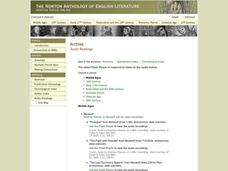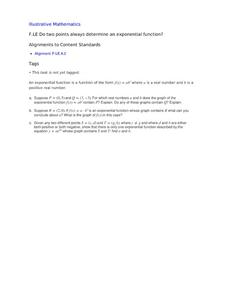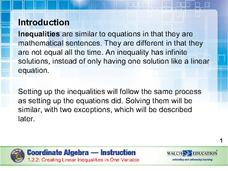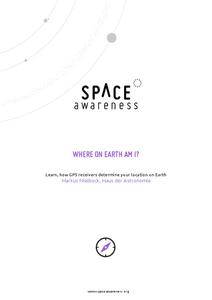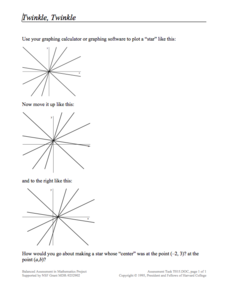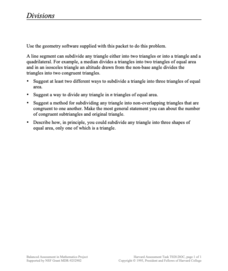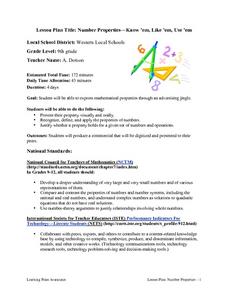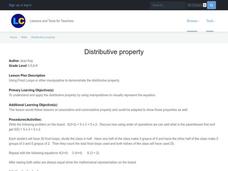Illustrative Mathematics
Fixing the Furnace
This comprehensive resource applies simultaneous equations to a real-life problem. Though the commentary starts with a graph, some home consumers may choose to begin with a table. A graph does aid learners to visualize the shift of one...
Illustrative Mathematics
The Physics Professor
Help mathematicians see that a formula found in a physics book has an algebraic structure. Though the formula given in the resource looks complicated, learners are to break down the expressions and interpret each part separately....
Curated OER
Do Two Points Always Determine an Exponential Function?
Algebra learners explore, analyze and build an exponential equation given its form and a specific point that exists on the function in this task. The last question asks learners to apply their ideas to an exponential equation given two...
Curated OER
Domains
Your algebra learners work to address the order of operations applied to an expression's input variable and the limitations that may be created because of it. This simple task of a few very well-chosen exercises is elegant in it's way of...
BW Walch
Creating Linear Inequalities in One Variable
Just when a young mathematician starts to feel comfortable turning word problems into linear equations, shake things up and throw inequalities in the mix. This excellent, instructive presentation takes the steps for solving an equality...
University of California
Energy and Biomass Pyramids
Young scientists play tag as they act out the food pyramid in the ocean ecosystem. Energy circles pass from the smaller prey to the predators and at the end of the activity, a data chart and analysis questions allow pupils to apply their...
Federal Reserve Bank
Expense Tracking
Where does all your money go? Individuals keep a record of the money they spend over the course of 30 days. They then categorize where they are spending their money and write an essay detailing their findings.
Balanced Assessment
Bouncing Off the Walls
Apply geometry concepts to improve your pool game! Here scholars create the perfect bank shot using angles of incidence and refraction. They create three different options for the same shot.
Balanced Assessment
Oil Consumption
An assessment presents a chart displaying oil consumption Pupils use the chart to determine the greatest increase in consumption, and then apply that information to figure out when the consumption may reach 100 million barrels a day.
Balanced Assessment
Mirror, Mirror II
Apply the concept of similar triangles to design a space in a room. Scholars use similar triangles to determine how a spotlight reflects from a mirror. After drawing the path of the spotlight, individuals find the smallest possible width...
Virginia Department of Education
Inductive and Deductive Reasoning
Introduce pupils to the two types of reasoning, inductive and deductive. Classmates work in pairs or small groups to learn the difference between the two and apply these reasonings to develop valid conclusions.
Space Awareness
Where on Earth Am I?
Almost every phone has GPS installed, but a large number of teens don't know how the technology works. An initial activity illustrates how GPS determines a location on Earth. Scholars then apply trilateration procedures to a...
Concord Consortium
Twinkle, Twinkle
Take a look at a star resource. Young mathematicians use a graphing calculator to draw intersecting lines that look like a star. They then apply translations to move the entire star and also consider what transformations must occur to...
Concord Consortium
Walled-Up Parabolas
Jump at the chance to use parabolas. Young mathematicians apply trigonometry to explore the trajectory of a ball in different situations. Some walls cause the ball to bounce, so participants must consider all possibilities.
Concord Consortium
Detective Stories
The truth will always come out. A short performance task has learners considering a witness statement given to a detective. They apply special line segments in triangles and Ceva's Theorem to prove that the witness is actually lying.
Concord Consortium
Divisions
Divide and conquer the geometry problem. Young scholars consider how to subdivide triangles into smaller ones that have equal areas. They must apply their knowledge of medians to help accomplish the task.
Curated OER
Not Everything Is More Expensive
Students investigate the concept of using different types of presentations to help solve mathematical problems. They research the use of illustrations to help understand data and its interpretation in a graphing format. Students also...
Curated OER
Number Properties - Know 'em, Like 'em, Use 'em
Ninth graders express mathematical properties through creation of advertising jingles.
Curated OER
Dimensional Analysis
In this mathematics worksheet, students apply dimensional analysis to solving each problem. They identify the conversion factor and describe a unique characteristic of a conversion factor. Students also identify the unit in the final...
Curated OER
Set Theory Review Using the TI Navigator
Students use technology tools and resources for managing and communicating personal/professional information. They select and apply technology tools for research, information analysis, problem solving, and decision making in content...
Canton Museum of Art
Personal Clay Box
High schoolers will love this geometrically exact ceramics project; they create a personalized clay box using the slab method and mathematical measurements. They utilize scoring and square construction and can decorate the boxes to...
Curated OER
High School Mathematics Problems from Alaska: Fire Fighting Crew
High schoolers apply mean, median and mode calculations of firefighter test scores to decide on hiring.
Curated OER
Number Properties-Know'em, Like'em, Use'em
Ninth graders explore mathematical properties through the use of an advertising jingle. They produce a commercial that is digitized and presented to the class. Students write a jingle that simplifies each property and helps classmates...
Curated OER
Distributive Property
Students explore the distributive property. In this algebra lesson plan, students are given Fruit Loops or other manipulatives and the class is divided in half. Each half of the class completes part of the equation to show that both...


